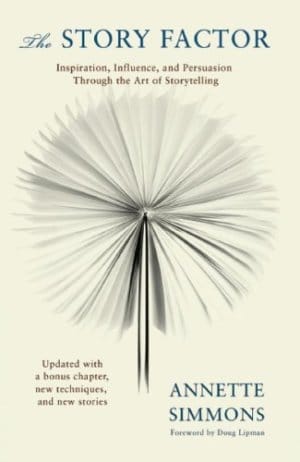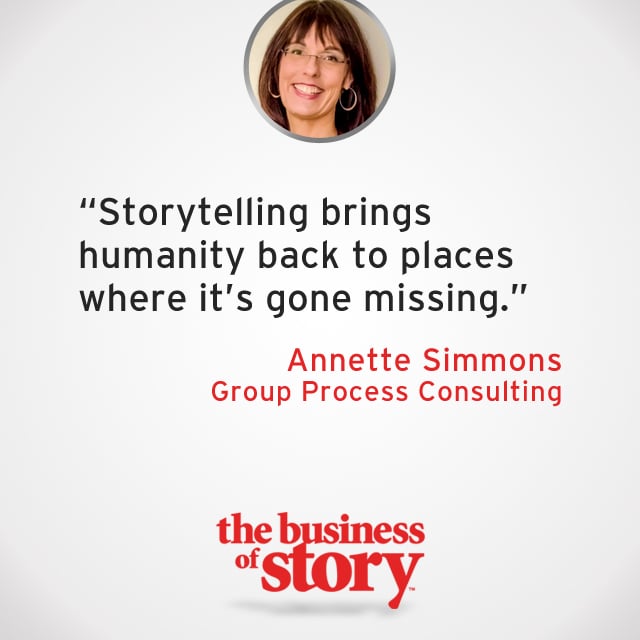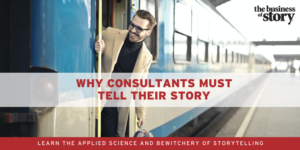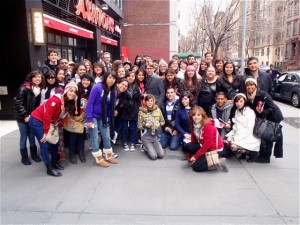There is no such thing as business-to-business marketing. Or B2B. It’s the greatest fallacy in our advertising vernacular.
Because no matter whether you’re selling to a c-suite suit, trying to persuade a rank-and-file employee to do something, or engaging a business customer, you are really marketing B2P: “business-to-people.” Or, if you dare, H2H: “human-to-human.”
We humans, especially those associated with your professional services firm, who you market to with a B2B mindset, love stories. In fact, science has proven that our minds cannot resist the suction of story.

If you want to humanize your B2B brand, and connect with your employees and customers like never before, then listen to my amazing guest on this edition of the Business of Story podcast: author, Annette Simmons, who wrote The Story Factor: Secrets of Influence from the Art of Storytelling.
I use this book in my Executive Masters for Sustainability Leadership program at Arizona State University as I teach our international executives how to use the art of storytelling to promote their social initiatives. One of the invaluable chapters in the book is about the six stories you need to know how to tell to connect with your audience.
Simmons details each kind of story with me on Business of Story. I’m going to try each one on you and see how you can use them in your business storytelling.
1. “Who I Am” Stories
If you are trying to influence someone, the first thing they question is “who is this person?” You may be wondering that about me right now.
I’ve been in the advertising business for 30 years. About 15 years ago, I wanted to figure out why some of our TV spots worked great while others kind of sucked. As our middle son, Parker Howell, went to film school at Chapman University in Orange, CA, I had him send me his textbooks so I could learn what Hollywood knows about storytelling. My plan was to apply their story craft to my work in the art of persuasion.
I learned about Joseph Campbell, America’s foremost mythologist, and created our proven Story Cycle process from his Hero’s Journey to use for brand story strategy development and activation. The outcome has been beyond my wildest dreams.

Our Proven Story Cycle Process for Brand Story Strategy Development
Now I teach, coach and consult executives in professional services firms how to use storytelling to humanize their B2B brands, as well as work with sustainability professionals around the world to advance their causes further, faster by using the power of story. And, I get to meet fascinating people like Annette Simmons.
2. “Why I am Here” Stories
Simmons said that people won’t cooperate with you if they smell a rat and figure you have a hidden agenda. They want to know what’s in it for you before they have confidence there’s something in it for them.
What’s in it for me is the joy of teaching and coaching storytelling in business to humanize executives and their offerings. I never knew this was my calling until ASU came calling. Bruno Sarda, Director of Social Responsibility for Dell, (who has also appeared on Business of Story) was co-creating the EMSL program in his spare time with George Basile, Ph.D. They asked if I would develop and teach the communications curriculum based on our proven Story Cycle process. I said sure, and the experience has been the single most rewarding endeavor in my communications career.

3. “The Vision” Story
If your audiences are comfortable with who you are and why you’re here, then they’re ready to hear what you think is in it for them.
If I ask 50 people in a Story Cycle workshop how many think they’re good storytellers, I’ll be lucky to have five hands go up. To me, that’s sad. I think we were all at the top of our storytelling game in kindergarten. But our educational system, corporate culture, social conformity and political correctness are just a few of the human conditions that have silenced our inner storytellers.
My vision for you is to re-ignite your innate storyteller – the one true superpower you posses – to advance your personal and professional missions further, faster. That is my promise to my clients and my students at ASU. And I’m fortunate to have stellar story artists like Annette agree to share their story wisdom with us on Business of Story.
That’s what’s in it for you.
4. Teaching Stories
Have you ever tried to teach someone to do something and they just don’t get it? It’s frustrating. Instead of getting pissed, use a story to help them “get it.” Simmons points out that “teaching stories” help us make sense of new skills in meaningful ways.
I once was in front of a room full of scientists and engineers who passively, but aggressively, dismissed communications as the “soft skill” in science. Facts rule! How was I going to teach these brilliant minds that facts and data are meaningless unless they are expressed through story to us meaning making machines?
I had to teach them in their language. I said let’s make an algorithm that we could all agree to define story structure. Since the two elements of story are information and emotion, how do we bring feeling to inert data? I drafted this equation:
(Data + context + metaphor) x story = meaning
I continued to argue that data does one of three things:
- Data records an event that has happened
- Data monitors an event that is currently happening
- Data attempts to predict an event that may happen
Our minds care about the event, because events can kill us. Data can’t. Stories take the audience by the hand through the event in question so they can experience vicariously in a subconscious rehearsal to determine what the brain would direct the body to do in case it happens to us. Data is just the back-up to test whether the event has happened, is happening, or could happen.
Some scoffed, yet many agreed that storytelling “perhaps” played a more important role in communicating science than they had first considered. Tough crowd. Brainiacs typically are.
5. “I Know What You Are Thinking” Stories
Can you tell a story that makes people wonder if you are reading their minds? When you do, they love it. It builds immediate trust in your audience for you.
You might be thinking that storytelling, especially in business, is just a gimmick. A “Soft skill.” But I can prove that it is as important to our brains for survival as air is to our lungs, and nutrition and water are to our bodies. Just consider that we can go weeks with out eating, days without drinking, but only about 35 seconds without our brains making meaning out of something in our environment to determine if it is friend of foe.
Just watch the Heider Simmel video in a study from 1944, and see if your brain doesn’t create a story in an attempt to create meaning out of what’s happening in this crude video.
We humans are meaning-making machines. And stories are more important to our survival now than ever.
6. “Values in Action” Stories
When teaching about values, it’s all about the “walk” and never about the “talk.” Values are best taught by example.
One of our EMSL students called me about a job he was interviewing for and asked if he could share his presentation with me. As his business storytelling teacher and coach, I was honored. In his interview he actually used a powerpoint, and to great affect, with just the right story about himself as the mentor who could help this agency (the hero) in his new role.
He began with a photo of a painting by a Navajo artist Landis Bahe called The Gift that expresses the value of sharing one’s talents with their community. This was the moral of his story: a value he expressed through the work he had done sharing his talents on with his community in the Four Corners region of America.

He felt the interview went well, but as often happens, it took a few weeks for the people to respond. He got antsy. Yesterday, he received the call.
The man on the phone said, “I have some bad news and I have some good news. The bad news is you didn’t get the job. We promoted from within. The good news is that we were so taken by your presentation, that we have created a position just for you.”
The caller went so far as to mention the painting and his point about sharing his talents with his people. Now that’s a “Values in Action” story that’s truly in action.
The end.
Can you now see how these six simple kinds of stories can help you humanize your presentations in a business environment and engage your audiences on a B2P or H2H level? Would you like to learn more?
Please join Annette Simmons and me on this Business of Story podcast, and learn from one of the best story artists in business.











